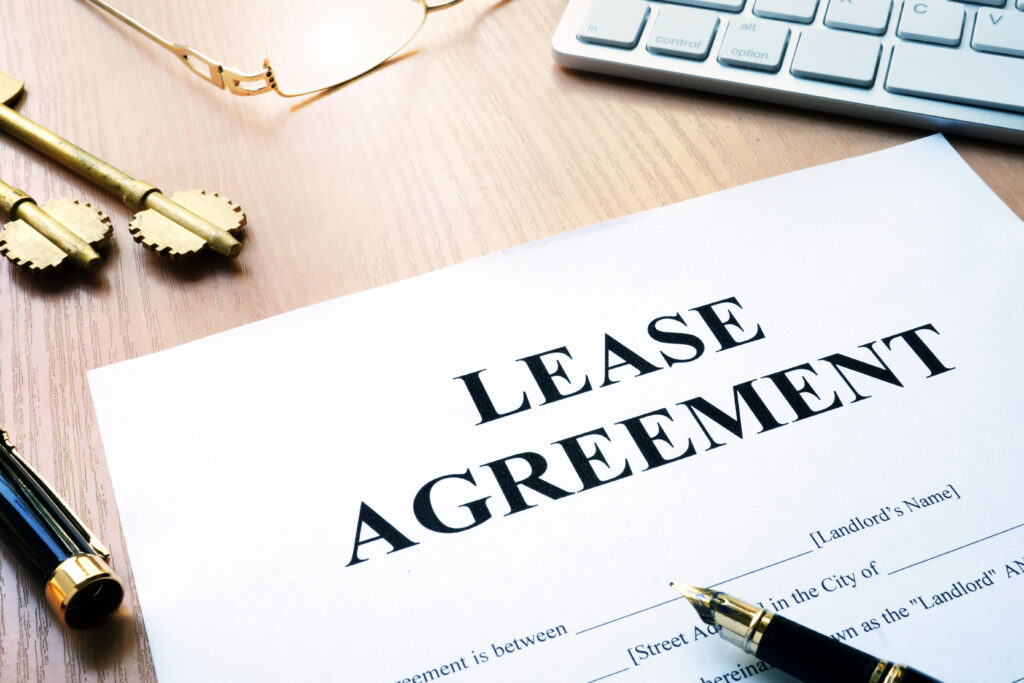

What is Assignment of Lease and How It Differs from Subletting
The assignment of lease (and rent) is a foggy topic that is often confused with subletting. Let's clear the air once and all right now. Learn the differences between a lease assignment and sublease so you can make the right choice.
What is Assignment of Lease? - The Important Basics
Let's begin by introducing the 3 players in a lease assignment - The landlord, the original tenant (assignor) and the new tenant (assignee). The original tenant has an unexpired lease agreement with the landlord and he wants out. Since the original tenant can't just break the agreement and walk off, what he does is to get a new tenant to swap places... and take over all his rights and obligations for the remainder of the lease period. So if the original tenant signs a 1 year commercial lease and the business goes bust after 8 months, the new tenant will be assigned a 4-month commercial lease (with the same terms and conditions as the original agreement). Now here's the big catch: Even though the original tenant has handed over all his duties and obligations to the new tenant, he is not off the hook... unless the landlord agrees to release him from all liabilities. If the new tenant stirs up trouble, our dear original tenant will find himself in hot soup as well. Of course, whether the original tenant is allowed to pull this assignment trick out of his hat is a whole new matter. Knowing for sure is actually simpler than most people think: First, examine your local landlord tenant laws for any lease assignment rules. Most of the time, landlords are given the right to allow or disallow assignments but once in a while, the local law let tenants have the final say instead. If there's no mention of lease assignments in your law text, then your rental lease agreement shall dictate the terms.
Difference Between Lease Assignment and Subletting
When it comes to subletting vs assignment of lease, there's often a massive mix-up. Sometimes even real estate professional get it wrong by assuming them to be one and same thing. However if you dig deeper, you will find that the differences are not just numerous, but important as well. Let's begin by dragging the landlord into the picture. An assignment of lease launches the new tenant into a direct relationship with the landlord - The landlord collects rent straight from the new tenant and deals with the new tenant directly on all lease issues. So in this case, the original tenant gets to take back seat and doesn't have to manage the new tenant actively. On the other hand, there's no direct relationship between the landlord and new tenant (subtenant) in a sublease. Instead the original tenant plays mother goose and is responsible for collecting rent from the subtenant and making sure that he's following the lease rules. When you compare the two, a sublease is a lot more hands-on for the original tenant. No matter which path you take, you will still want a good new tenant who pays the rent on time and follows the lease rules to the agreement. For the golden rules on screening tenants and running credit checks, Click here for our guide to running tenant credit checks. When you have a lease assignment, the terms and conditions of the lease remains largely unchanged - It's almost like taking the original lease agreement and swapping the tenant's name with another. With a sublease, there's more breathing space - The original tenant can decide how much rent to charge, how long the subtenant is going to stay or even collect security deposit... as long as it stays within the boundaries drawn by the original lease agreement between the landlord and original tenant.
Should You Choose Assignment of Lease or Sublease?
You are the Landlord - A lease assignment is recommended in most cases. You will have more control over your new tenant (instead of leaving matters in the original tenant's hands and hoping that he would do a good job)... plus you still have the original tenant to cover your back in case anything goes wrong. You are the Original Tenant - Now this is a tricky one. If you want to someone to take over the entire lease and property for its remaining duration (e.g. your business goes belly-up and you no longer need the office), then help yourself to a lease assignment. If the landlord's consent is required for assignment (and he doesn't give the nod), you can always try offering him a lease assignment fee as a deal sweetener. However, if you are looking for someone to share the place (and rent)... or perhaps you need someone to cover the rent while you are overseas for a few short months, then a sublease would be ideal. You are the New Tenant - An assignment of lease works better for you most of the time. You won't be at the mercy of the original tenant (for example if he screws up and the landlord terminates the original lease agreement, your sublease might also go up in flames). But if you only want to rent part of the property... or don't want to tie yourself down for the remaining lease duration, then you are better off sticking to a sublease. Now that we have covered the topic of assignment vs sublease, go ahead and take your pick - Click here for an assignment of lease form or Click here for a sublet agreement instead.
Landlord Tenant Law
- 3 Methods of Resolving Landlord Tenant Disputes
- Federal Fair Housing Act - Avoiding Discrimination
- Security Deposit Laws for All U.S. States
- U.S. State Laws on the Return of Security Deposit
- Sublet Laws - Subletting Laws for All U.S States
- Assignment of Lease and How it Differs from Subletting
- Guide to Commercial Landlord Tenant Law
- How to Find a Good Real Estate Lawyer
- What to Look for When Hiring a Real Estate Attorney
Becoming a Landlord
- Buying Rental Property
- Financing Properties
- First Time Landlord
- Property Manager Career
- Managing Tenants
- Tenant Screening
- Tenant Credit Check
- Rent Payment
- Security Deposit
- Property Maintenance
Landlord Tenant Rights
- Types of Tenancy
- Breaking a Lease
- Section 8 Landlord
Accounting & Taxes
- Landlord Insurance
- Landlord Accounting
- Rental Property Tax
- Landlord Resources
- Landlord Software
- Landlord Tenant Forms

Privacy Policy
© 2008- Propertydo.com. All Rights Reserved.
- Find a Lawyer
- Ask a Lawyer
- Research the Law
- Law Schools
- Laws & Regs
- Newsletters
- Justia Connect
- Pro Membership
- Basic Membership
- Justia Lawyer Directory
- Platinum Placements
- Gold Placements
- Justia Elevate
- Justia Amplify
- PPC Management
- Google Business Profile
- Social Media
- Justia Onward Blog
Subleases and Assignments by Tenants & Related Legal Concerns
Some landlords allow a tenant to sublet their unit to a third party, while others do not. If you are considering this option, you should check your lease or rental agreement to make sure that it is permitted. Even if it is not explicitly prohibited, you should get your landlord’s permission in advance to minimize future disputes.
How a Sublease Works
A subtenant is not a co-tenant and does not have a direct relationship with your landlord. As their “landlord,” you can (and should) require them to pay rent directly to you and evict them if they fail to follow through. This differs from a co-tenant, who can be evicted only by your landlord. If you decide to evict your subtenant, you will need to follow the same procedures that would be required of a landlord. A month-to-month rental agreement may be better for a subtenant arrangement than a lease. Any agreement should clearly state the amount of the rent, the length of the tenancy, and any security deposit that may be required.
A tenant will usually need their landlord’s permission before subletting their unit, but some state or local laws may prevent landlords from unreasonably denying subleases.
You should be aware that any benefits that you give your subtenant must fit within the overall rules that the landlord imposes for the property and the people who live there. Even though the subtenant did not sign your lease with the landlord, its terms apply to them as well.
You should make sure that you are confident about the subtenant’s financial situation and ability to comply with the terms of the sublease and the landlord’s rules. If they fail to pay rent or damage the property, you will be on the hook to the landlord for all of your own rent and the cost of any repairs. In extreme situations, such as criminal activity by your subtenant, the landlord may evict you in order to remove the subtenant. You also may face an eviction if you get into a dispute with your subtenant. If they refuse to leave when you return, for example, it may be easier for the landlord to simply evict both of you.
Can a Subtenant Turn Into a Tenant?
A subtenant can turn into a tenant if the landlord and you start acting as though the subtenant is a co-tenant. The most common issue here is who receives rent from the subtenant. If they start paying the landlord rather than you, they will have a strong argument that they are the landlord’s tenant. To prevent your subtenant from gaining the rights of a co-tenant, you should make sure that they pay rent to you, and then you can send it to the landlord.
Assigning a Lease
While assignments are often discussed together with subleases, they should not be confused. An assignment transfers the rest of your lease to a new tenant, and it usually happens when you want to move out before the lease is over. While a sublease makes you the landlord of the subtenant, an assignment makes the assignee a tenant of your landlord. All of the terms of your existing agreement with the landlord most likely will apply to the assignee. (There is an exception if the agreement contains a personal term, such as handling errands for the landlord in exchange for reduced rent.) The original tenant, the assignee, and the landlord all will need to sign the assignment document for it to become valid.
The original tenant will remain liable for rent that the assignee does not pay unless the landlord agrees otherwise.
Assignments can be risky because the original tenant remains on the hook to the landlord for all of the remaining rent if the assignee fails to pay it. This essentially makes the original tenant a guarantor for the rent, so it may be more appealing to try to terminate the lease early and let the next tenant start a new lease. Sometimes, however, you can work around this default rule and get the landlord’s consent to take you off the hook for any rent that the assignee does not pay.
Vacation Rentals (Airbnb)
Many tenants try to earn extra money by listing a home as a short-term vacation rental on websites like Airbnb. You should make sure that your lease permits this type of rental, since you may face eviction if you use Airbnb without your landlord’s authorization. You should get any ensuing agreement with your landlord in writing. It should cover issues such as how much of your unit will be leased to the short-term renter, how often you can list on Airbnb, and financial considerations such as any amount of the Airbnb rent that the landlord receives.
In addition to getting your landlord’s permission, you will want to make sure that listing your home for a short-term vacation rental complies with any zoning or land use laws in your area. You must comply with any restrictions in these laws, even if your landlord does not require it.
Finally, you may want to purchase renters’ insurance, while being aware that it may not cover people in a vacation rental. Some insurance companies are extremely reluctant to provide policies to people who plan to list on Airbnb or similar services.
Last reviewed October 2023
Landlord - Tenant Law Center Contents
- Landlord - Tenant Law Center
- Choosing a Place to Rent & Legal and Financial Concerns
- Understanding Leases and Rental Agreements & Their Legal Implications
- Changing a Lease or Rental Agreement
- Rent Rules and the Legal Rights & Obligations of Tenants
- Security Deposit Rules & Tenants' Legal Rights
- Inspecting a Rental Property Before Signing a Lease
- Co-Tenants' Legal Rights & Obligations on a Lease
- Subleases and Assignments by Tenants & Related Legal Concerns
- Major Repairs to Rental Property & Tenants' Legal Options
- Minor Repairs to Rental Property & Tenants' Legal Options
- Improvements, Alterations, and Fixtures on Rental Property
- Tenants' Legal Rights to Privacy
- Injuries to Tenants on Rental Property & Related Legal Claims
- Environmental Hazards on Rental Property & Enforcing Tenants' Legal Rights
- Inadequate Security at Rental Property & Tenants' Legal Options
- Terminating a Lease of Rental Property & Related Legal Rights and Obligations
- Abandoning Personal Property When Leaving a Rental Unit
- Recovering a Security Deposit When Leaving a Rental Unit
- Resolving Disputes With Your Landlord Without a Lawyer
- Responding to Legal Notices Terminating a Tenancy
- The Eviction Legal Process for Tenants
- Working With a Tenants' Rights Lawyer
- Tenants' Legal Rights & Duties — FAQs
- Landlords' Legal Rights & Duties
- Housing Discrimination Law
- Eviction Laws and Forms: 50-State Survey
- Find a Landlord Tenant Lawyer
Related Areas
- Consumer Protection Law Center
- Civil Rights and Discrimination Legal Center
- Foreclosure Law Center
- Animal and Dog Law Center
- Related Areas
- Bankruptcy Lawyers
- Business Lawyers
- Criminal Lawyers
- Employment Lawyers
- Estate Planning Lawyers
- Family Lawyers
- Personal Injury Lawyers
- Estate Planning
- Personal Injury
- Business Formation
- Business Operations
- Intellectual Property
- International Trade
- Real Estate
- Financial Aid
- Course Outlines
- Law Journals
- US Constitution
- Regulations
- Supreme Court
- Circuit Courts
- District Courts
- Dockets & Filings
- State Constitutions
- State Codes
- State Case Law
- Legal Blogs
- Business Forms
- Product Recalls
- Justia Connect Membership
- Justia Premium Placements
- Justia Elevate (SEO, Websites)
- Justia Amplify (PPC, GBP)
- Testimonials

- Legal GPS for Business
- All Contracts
- Member-Managed Operating Agreement
- Manager-Managed Operating Agreement
- S Corp LLC Operating Agreement
- Multi-Member LLC Operating Agreement
- Multi-Member LLC Operating Agreement (S Corp)
Demystifying Assignment of Lease: Your Go-To Guide
LegalGPS : July 29, 2023 at 8:17 AM
When you’re talking about property leasing, it’s important to understand that there are a lot of terms and concepts that you may have never heard before. One of them is the assignment of lease, which refers to a situation where a tenant transfers their rights and responsibilities under the lease agreement to another party.

What is an Assignment of Lease, and why is it so crucial?
An Assignment of Lease is a term you may have heard thrown around, especially if you're involved in rental properties. It’s a pretty important document. But what exactly is it? Well, in simple terms, an Assignment of Lease is an agreement where the original tenant of a property transfers their leases and all of its rights and obligations to a new tenant. Now, you might be wondering, "When would this scenario ever occur?"
Let's imagine you're a tenant who signed a three-year lease for an office space. However, two years in, you need to relocate due to unprecedented growth of your business. Instead of breaking the lease, you might choose to assign your lease to another business looking for office space. This means that you, as the original tenant, no longer have any obligations under the lease. The new tenant is now responsible for paying rent and complying with all of the terms of the previously signed agreement.
Now that you understand, let's get into the step-to-step guide on how to create an Assignment of Lease!
Steps to Write an Assignment of Lease
Creating a thorough Assignment of Lease agreement doesn't need to be an overwhelming task. Simply follow these steps to ensure your agreement is both comprehensive and legally binding:
Step 1: Identify the Parties
The information of each party should be included. For the existing tenant (the assignor), make sure to include:
Full legal name or business name
Postal mailing address
Phone number and email address
Do the same for the new tenant (the assignee). Make sure all the information is up-to-date and accurate to avoid any unnecessary confusion or disputes. For example, if the assignor is a business, make sure they have updated their mailing address with the post office to reflect their new building location. If a party has multiple addresses, be sure to list them all.
Step 2: Specify the Lease
This section requires exact information from the original lease agreement, including:
Property address and description
Lease start and end date
A reference to the original lease agreement (for instance, a sentence like "the lease agreement dated...")
Remember to include a copy of the original lease as an attachment to ensure the assignee understands the terms they're adhering to. If not already included in the original lease agreement, be sure to add the following information: Description of rental property, Lease term (how long the lease is good for), Rent amount, and Security deposit amount.
Step 3: Detail the Assignment
State that the assignor is transferring all their interests and obligations in the lease to the assignee. Here, write something like:
"The Assignor hereby assigns, transfers, and conveys to the Assignee all of the Assignor's rights, title, and interest in and to the Lease, together with all the Assignor's obligations, liabilities, and duties under the Lease."
This means that the assignor is transferring all of their interests and obligations in the lease to the assignee. This includes any future rent payments, repairs and maintenance responsibilities, notices of default by either party, and so on.
Step 4: Landlord's Consent
Many leases require the landlord's consent to assign the lease. The assignor should request written consent from the landlord and include a clause like:
"The assignment of the lease is not valid unless and until the landlord provides written consent."
This is followed by a place for the landlord to affirm consent by signing or initialing. This is important because the landlord can elect to withhold consent and the assignment will not be valid. If this is the case, you may need to provide additional consideration for your landlord's assent (for example, an increase in rent).
Step 5: Assignee Acceptance
Include a statement in which the new tenant agrees to the assignment and the terms of the lease. It may look like:
"The Assignee hereby accepts this assignment, assumes all duties and responsibilities under the Lease, and agrees to perform all of the Assignor's obligations under the Lease."
You need to do this because the new tenant needs to have an affirmative acceptance of the assignment in order for it to be valid. This is typically done through a letter from the assignee stating that they agree to perform all of your obligations under the lease.
Step 6: Signature and Date
Every binding legal document needs a date and a signature. Make sure that there is a proper place for the assignor and the assignee to sign and print their names, with a line for the date.
By following these clear, actionable steps, you'll be able to construct an effective Assignment of Lease agreement. Remember, every situation is unique, so adjust the template as necessary, being sure to include all relevant details.
Clear so far? Great! Now, let's focus on the tips to draft a perfect Assignment of Lease.
Tips to Draft a Perfect Assignment of Lease
Accurate Dates: Be sure to include the date when this agreement will take effect. Precision avoids any confusion about durations, when the assignee takes over, or when the assignor's obligations end.
Clear Terms: This document should restate the terms of the original lease. The assignee needs a clear understanding of what they're stepping into. Bit ambiguous? Think of it like this: the assignee should be able to step into the assignor's shoes comfortably.
Specify Rent Terms: Stating the rent amount, due dates, and method of payment in the assignment helps create a record of the agreed-upon rent terms, ensuring no misunderstanding arises in the future.
Specify the Term: The assignment should state how long the new lease lasts. For example, if the original lease is for one year, then the assignee will assume only a one-year term.
Specify Other Conditions: If there are other conditions in place—such as tenant improvements or utility allowances—then specify these too.
An assignment of lease doesn't have to be a formidable task to overcome. With a cautious and considered approach, these documents can be a smooth and seamless part of managing a successful lease transition.
Our contract templates can offer you even more support, empowering you towards crafting an excellent and individualised Assignment of Lease ready for your task. So why not take your next step towards leasing success and check them out today? Click here to get started!
Navigating the assignment of a residential lease
A landlord can assign his leases to a new buyer of his building. Likewise, a tenant may be able to assign his lease if he needs to relocate. Find out how to assign your lease and what you can do to protect yourself when doing so.

by Ronna L. DeLoe, Esq.
Ronna L. DeLoe is a freelance writer and a published author who has written hundreds of legal articles. She does...
Read more...
Updated on: December 4, 2023 · 3 min read
Assignment of lease by the tenant
Assignment of lease vs. sublease, assignment of lease by the landlord.
As a tenant, you may want to get out of your residential lease without paying the remaining rent. Likewise, if you're a landlord and sell your rental property, the buyer must now collect rent from the tenants, who may have no idea you sold the property. In both situations, assignment of a lease with a release for the tenant and assignment of leases with notice by the landlord accomplish these goals.

If you're the tenant and want to leave before the end of your lease term, you may be able to assign your lease to a third party if the landlord doesn't let you out of the lease. The third party then becomes the new tenant, who is bound by the terms of the original lease and pays rent to the landlord.
Most often, the lease won't permit assignment without the landlord's approval, but leases often state that the landlord cannot unreasonably withhold consent. As long as you produce a tenant who's shown a history of payment under prior leases and has been a model tenant, a landlord should consent to assignment.
The assignment of lease form should include places for the tenant-assignor, the new tenant-assignee, and the landlord to sign. If the master lease allows assignment, then the tenant doesn't need the landlord's permission; the tenant can sign an assignment of lease agreement without the landlord's signature.
If the landlord allows an assignment of the lease, you, as the tenant, also want him to sign a release stating that you're not responsible for the new tenant's failure to pay or for any damage she causes. Without such a release, you may still be liable for both.
When you, as the tenant, assign the lease, you sign an agreement that either reads “Assignment of Lease," “Lease Assumption Agreement," or “Assignment and Assumption Agreement." An assumption of the lease means that the new tenant assumes your obligations, such as paying rent and keeping the apartment in good condition.
An assignment of a lease transfers the tenant's entire rights in the property to a third party. With a sublease, on the other hand, the tenant transfers only a portion of the remaining lease. For example, if the original tenant has six months remaining on his lease and he gives the entire six months to a third party, the tenant is permanently assigning his rights to live on the property to the third party. If, however, the tenant allows that third party to stay at the premises for only three months, and the tenant intends to return after three months, he is subleasing the premises.
A landlord can assign the right to collect rent to someone who has purchased the property. An assignment of lease from the seller to the buyer allows the new landlord to collect rent from any and all current tenants in the building. The language in the landlord's assignment of lease agreement can include assignment of security deposits, if the parties agree to it. An assignment of leases by the landlord to the buyer affords protection to the buyer so he can collect rent.
An assignment of leases by the landlord to the buyer is meaningless if tenants aren't aware the landlord sold the property, which is why it's important for the assignor-landlord to give tenants proper notice. A notice of assignment of lease, which is a form signed by both the assignor-landlord and the assignee, or new landlord, is one way to give notice. Another way is to send a letter on the landlord's letterhead. Either way, the notice must include the new landlord's address and how rent is to be paid.
Both landlords and tenants who become assignors should sign a formal assignment of lease agreement, which an online service provider can prepare for you. If you're the tenant who has assigned your lease, try to get a release or you'll still be liable to the landlord. If you're the landlord, make sure you can count on the new tenant to pay the rent before you release the primary tenant from his obligations under the lease.
You may also like

What does 'inc.' mean in a company name?
'Inc.' in a company name means the business is incorporated, but what does that entail, exactly? Here's everything you need to know about incorporating your business.
October 9, 2023 · 10min read

How to get an LLC and start a limited liability company
Considering an LLC for your business? The application process isn't complicated, but to apply for an LLC, you'll have to do some homework first.
March 21, 2024 · 11min read

What is a power of attorney (POA)? A comprehensive guide
Setting up a power of attorney to make your decisions when you can't is a smart thing to do because you never know when you'll need help from someone you trust.
February 8, 2024 · 15min read

Assignment, Subleasing, And Why It's Important To Negotiate The Right To Do Both

Share this article
In the market for commercial space? Chances are you’re focusing your efforts on sourcing a property that suits your current business requirements.
However, in today’s ever-changing economy/business climate, companies often need to upsize or downsize at short notice.
As a tenant, where does that leave you when locked into a long-term commercial lease?
Keep it flexible
It’s hard to anticipate whether you’ll be faced with breaking a lease before it happens. So, it’s important to keep your contract flexible by negotiating a subleasing and assignment clause into your agreement. This means you’ll be able to transfer all or part of your space to another tenant down the track if the situation calls for it.

What’s the difference between an assignment and a sublease?
Lease assignments and subleases are often viewed in a similar light. This is because both bank on a third party taking over a commercial lease. But, there are some important differences to consider:
Lease assignment
A lease assignment is when an entire property/space, including the existing tenant’s rights and interest in the commercial lease, is transferred over to a new party.
When it comes to leasing assignments, the new tenant takes on the rights and responsibilities of the assigning tenant. That means the original tenant is not liable anymore if the new tenant breaches the lease.
Lease assignment is best undertaken when:
- The whole lease can be disposed of
- The current lease has favourable terms that would be accepted by another tenant
Major hurdles when it comes to lease assignment:
- Requires upfront capital incentive
- Requires landlord consent
A sublease, on the other hand, is a separate contract between the original tenant and a subtenant. Unlike an assignment, a sublease only turns over part of a property. That means that the original tenant shares the rights and responsibilities to the premises.
A sublease may be preferable for tenants who wish to lease out part of their property to another company for the remainder of the lease term. It may also suit if a tenant needs to rent out the entire property for a period within their fixed-term lease.
In this case, the sublessee treats the sublessor as their landlord. In turn, the sublessor assumes liability on behalf of the sublessee.
Subleasing is best undertaken when:
- You're looking for a partial or temporary cost saving initiative
- Your landlord does not consent to or permit assignment
- Your current lease has. onerous clauses that another tenant wouldn’t agree to
Major hurdles when it comes to subleasing:
- Inherent security risks
- You’ll likely recuperate less than 50%-70% of the rent
You can learn more about some of the benefits of commercial subleasing here and what commercial sublessors should expect from subleasing here .

The importance of a lease assignment and sublease clause
The right to assign or sublet a premises comes down to the language used in the commercial leasing agreement.
If there is no prohibiting or limiting clause, a tenant does not need the landlord’s permission to do so. However, if the contract contains such provisions, the existing tenant needs to get the landlord’s consent. This can prove quite costly for the tenant, who may have to continue to pay rent even if they no longer occupy the premises.
Other options for breaking a commercial lease
The odds usually aren’t stacked in the tenant’s favour when it comes to breaking a commercial lease . However, if you used a tenant representation specialist before signing your contract, you should have received the right advice to protect yourself.
Break clause
Well negotiated leases may have a ‘break clause’, however, most landlords are reluctant to include one of these. A break clause basically lays out the circumstances and the manner in which a tenant can break a commercial lease early.
As with any contract, it’s up to the two parties to negotiate terms. One option may be to allow early termination of a lease if a new tenant with similar financial security takes over. This is similar to an assignment. However, the new tenant would take over the full liability of the remaining lease.
Pay out the commercial lease term
Not a desirable option for most tenants, however, there may be situations where it is the only choice. For example, if you were closing your business before the expiry of your lease term and there was no way to arrange an assignment or sublease, paying out the remainder of your term may be the only course of action.
Most people would consider this a worst-case scenario. This, again, highlights the importance of seeking the help of a tenant representation specialist prior to signing any commercial lease .
Commercial tenants should try to mitigate their risks upfront. Before signing a lease, or even at the heads of agreement stage , we suggest negotiating a clause which requires a landlord to act reasonably in the case of lease assignment or sublease.

Work with a commercial tenant advocate
Negotiating commercial lease terms can be tricky (even daunting at times). This is because most businesses only have to do it once every 5-10 years. Being able to negotiate provisions that would not otherwise be included may also prove challenging because landlords prefer not to limit their options.
Luckily, an experienced tenant representative will guide you through the lease negotiation process so your needs are met every step of the way. So, the next time you face a lease negotiation, let Tenant CS balance the playing field.
Considering breaking your lease? Whether you're exploring options like subleasing, assigning, or surrendering, a detailed property strategy is crucial.
Consulting with a tenant representation specialist is your best move, especially if there's less than a year remaining on your lease. At Tenant CS, we exclusively represent tenants, not landlords. Whether you need assistance with subleasing, exiting your lease, finding and negotiating a new lease, or undertaking a mid-lease rent review, appointing us can potentially save you hundreds of thousands of dollars over your lease term while protecting your interests.
Book a call with us today to discover how we can help you effectively negotiate your next lease or exit your current lease early !
You might also like

Why Tenant Representatives Are More Valuable Now Than Ever Before

Options to Renew: How They Work & Why We Often Advise Against Exercising Them

10 Reasons It Pays To Partner With A Tenant Rep
-min%20(1).png)
Got a project in mind?
Let us represent you.
Tenant Representation
- Office Relocation
- Lease Negotiation
- Stay vs. Relocate
- Blend and Extend
Consulting Services
- Portfolio Analysis
- Portfolio Management
- Serviced Offices & Coworking
- Space Planning and Design
Get to know us
- Our Clients
- Success Stories
- News & Insights
- Careers We're hiring!
- Book a Discovery Call
We acknowledge the Traditional Custodians of the lands on which we work. Our offices are located on the land of the Gadigal peoples of the Eora Nation and the Wurundjeri peoples of the Kulin Nation. We acknowledge their continued connection and contribution to land, water and community, and pay our respects to Elders past and present.

We’re proud to be an inclusive workplace, where diversity in all its forms are valued and every member of our team is encouraged to bring their whole self to work.

.
Assigning vs. Subletting A Commercial Lease

Most commercial lease arrangements allow tenants to rent-out their usable space to a third-party renter. Although this can be a cost-effective way to maximize commercial space, tenants must be careful: when a tenant decides to rent part or all of their commercial space to a third-party, they are fully responsible for the actions or inactions of the new renter.
When it comes to commercial real estate, a legally-binding agreement is often signed between a landlord and a tenant. But when the tenant decides to sublet or assign their lease to a third-party, they become the sublessor, while the new third-party renter becomes the sublessee. Sometimes, the sublessor and sublessee are referred to the primary and secondary tenant respectively.
In any case, there’s only one legally liable party in the sublessor-sublessee relationship: the sublessor. In other words, should the sublessee damage the property or fall-behind on payments, compensating the landlord is the primary tenant’s legal obligation. Nonetheless, choosing a trustworthy and reliable third-party renter often results in a winning situation for both parties.
Get a Lawyer to Review Your Lease
Can I Rent Out my Commercial Unit?
In most instances, tenants are indeed allowed to rent their commercial space to third-party renters. However, this is usually up to the discretion of the landlord. Likewise, subletting must be done in-compliance with local state- and municipal-laws.
Before making any commitments to potential renters, tenants should ensure they are legally allowed to rent their usable space. This determination often depends on three factors:
- State- and Municipal-Regulations
- The Original Commercial Lease Agreement
- Landlord Consent
First—and perhaps foremost—tenants should review their local housing regulations. Some areas require a landlord’s written-consent before tenants can sublet or assign their lease. Even when states don’t make landlord-consent a prerequisite, landlords themselves often write provisions into the original lease that ensures permission is granted before subletting. Thus, you’ll need to revisit the terms and conditions of your original commercial lease agreement.
The original lease should contain specific language about subletting, however these provisions are oftentimes absent. If subletting provisions are indeed missing, you’ll need to speak to the landlord directly. So long as the landlord’s permission is granted and the arrangements are compliant with local laws, tenants are allowed to rent-out their unit to whom every they wish. Primary tenants that meet these requirements typically have two options: they can 1) sublet their commercial lease, or 2) assign their commercial lease.
Subletting vs. Assigning the Lease
Subletting and assigning are two different ways to structure the relationship between a primary and secondary tenant. Although the structures are similar, they have important practical differences.
- Lease-Assignment: the complete transfer of rental rights from a primary tenant to a third-party renter (importantly, the primary tenant is still responsible for the terms of the original lease)
- Subletting: the partial transfer of rental rights from a primary tenant to a third-party renter, usually for a temporary period of time or for only a portion of the usable space
When a tenant assigns their lease to a third-party renter, they are offering the entirety of their usable space without the intention of returning. This is unlike a conventional sublease structure, which offers only part of the unit and usually for a temporary period of time.
Why would a business owner want to assign their commercial lease? Importantly, a tenant is legally obligated to carry-out the terms of their commercial lease agreement, regardless of the circumstances. Lease-assignment is practical when original tenants cannot—for whatever reason—uphold their end of the lease. For example, if a business owner signs a 3-year commercial lease, but goes out of business 2-years into the agreement, they’ll likely seek somebody to complete the final 12-months of the term.
On the other hand, if a primary tenant is only interested in splitting their usable space or looking for a temporary third-party renter, subletting is the more practical option.
Who is the Responsible Party?
The commercial lease between the landlord and tenant is a legally-binding document. Regardless of the tenant’s situation, they are required by-law to carry-out the terms and conditions of the contract. Even when a lease is assigned to a third-party renter, the primary tenant is still responsible for the rental obligations.
Perhaps unsurprisingly, the same rules apply to subletting. When a tenant sublets their usable space, they remain the sole responsible party; should the third-party renter fail to make payments or cause damage to the rental unit, the original tenant is responsible.
Verbal or written agreements between tenants and third-party renters are great for establishing rules and responsibilities, but are more-so personal arrangements and not legally enforceable. For this reason, it’s imperative that choosing a third-party renter is given ample consideration—regardless if you’re assigning your lease or simply looking to sublet. It’s not unfair to request bank statements, criminal histories, or credit reports before making a commitment to a secondary tenant.
In some situations, landlords will in-fact release the original tenant from liability when the lease is assigned to a third-party renter, rendering the new renter responsible for the terms of the original lease. This is sometimes called “permeant assignment” and is definitely worth exploring when considering lease-assignment. Usually this stipulation is negotiated between the landlord and tenant; an experienced legal professional may be helpful in these situations.

Related Articles

- Why We're Different
- Our Legal Team
- Sell Your Practice
- Legal Dictionary
This website is lawyer advertising and no attorney-client relationship or obligation arises from your use of this site, by submitting information through the site, or by calling our office.
Interested in more referrals? Check out the first referral platform for independent business attorneys.
© 2024 BizCounsel, Inc.
- Terms of Use
- Privacy Policy
AGRASOY REALTY
Experts in Montreal Rental Market & Property Management
- Lease Assignment and Sublease
Assignment of Lease (Lease Transfer) vs. Sublease
by emre · Published October 4, 2014 · Updated October 12, 2014
The lease transfer (assignment of lease) is a foggy topic that is often confused with subletting. Let’s clear the air once and all right now.
What is Assignment of Lease? There are the 3 players in a lease assignment: the landlord, the original tenant (assignor) and the new tenant (assignee).The original tenant has an unexpired lease agreement with the landlord and (s)he wants out. Since the original tenant can’t just break the agreement and walk away, what (s)he does is to get a new tenant to swap places… and take over all his/her rights and obligations for the remainder of the lease period.
So if the original tenant signs a 12-month lease and the tenant has to leave town or finds a better place after 8 months, the new tenant will be assigned a 4-month ease (with the same terms and conditions as the original agreement). Now here’s the big catch: Even though the original tenant has handed over all his duties and obligations to the new tenant, (s)he is not off the hook… unless the landlord agrees to release him/her from all liabilities. If the new tenant stirs up trouble, the original tenant will find himself/herself in hot soup as well. Of course, whether the original tenant is allowed to pull this assignment trick out of his hat is a whole new matter. Knowing for sure is actually simpler than most people think: First, examine your local landlord tenant laws for any lease assignment rules. Most of the time, landlords are given the right to allow or disallow assignments but once in a while, the local law let tenants have the final say instead. If there’s no mention of lease assignments in your law text, then your rental lease agreement shall dictate the terms.
Differences Between Lease Assignment and Subletting
When it comes to subletting vs. assignment of lease, there’s often a massive mix-up. Sometimes even real estate professional get it wrong by assuming them to be one and same thing. However if you dig deeper, you will find that the differences are not just numerous, but important as well.
Let’s begin by dragging the landlord into the picture. An assignment of lease launches the new tenant into a direct relationship with the landlord – The landlord collects rent straight from the new tenant and deals with the new tenant directly on all lease issues. So in this case, the original tenant gets to take back seat and doesn’t have to manage the new tenant actively.
On the other hand, there’s no direct relationship between the landlord and new tenant (subtenant) in a sublease. Instead the original tenant plays mother goose and is responsible for collecting rent from the subtenant and making sure that he’s following the lease rules. When you compare the two, a sublease is a lot more hands-on for the original tenant.
No matter which path you take, you will still want a good new tenant who pays the rent on time and follows the lease rules to the agreement. For the golden rules on screening tenants and running credit checks. When you have a lease assignment, the terms and conditions of the lease remains largely unchanged – It’s almost like taking the original lease agreement and swapping the tenant’s name with another.
With a sublease, there’s more breathing space – The original tenant can decide how much rent to charge, how long the subtenant is going to stay or even collect security deposit… as long as it stays within the boundaries drawn by the original lease agreement between the landlord and original tenant.
Should You Choose Assignment of Lease or Sublease?
You are the landlord – A lease assignment is recommended in most cases. You will have more control over your new tenant (instead of leaving matters in the original tenant’s hands and hoping that he would do a good job)… plus you still have the original tenant to cover your back in case anything goes wrong.
You are the Original Tenant – Now this is a tricky one. If you want to someone to take over the entire lease and property for its remaining duration , then help yourself to a lease assignment. If the landlord’s consent is required for assignment (and he doesn’t give the nod), you can always try offering him a lease assignment fee as a deal sweetener.However, if you are looking for someone to share the place (and rent)… or perhaps you need someone to cover the rent while you are overseas for a few short months, then a sublease would be ideal.
You are the New Tenant – An assignment of lease works better for you most of the time. You won’t be at the mercy of the original tenant (for example if (s)he screws up and the landlord terminates the original lease agreement, your sublease might also go up in flames).
Please fell free to contact us if you have additional questions.
Tags: assignee assignor landlord lease assignment lease transfer leasee Montreal rent sublease sublet tenant
You may also like...

Can I break my lease in Quebec?
October 11, 2014
by emre · Published October 11, 2014 · Last modified August 27, 2020

Are you an owner who just purchased a beautiful unit at 1 Square Phillips and you need condo management services? Contact us now!
December 27, 2023
by emre · Published December 27, 2023 · Last modified January 23, 2024

Live in Style at Le Must: Modern Rentals in Lachine
March 26, 2024
by emre · Published March 26, 2024
Leave a Reply Cancel reply
Your email address will not be published. Required fields are marked *
- Next story Can I break my lease in Quebec?
- Previous story
Agrasoy Realty 2700 Rufus-Rockhead, Suite: #101 Montreal, QC H3J 2Z7 (514) 476-7281 [email protected]
Agrasoy Realty Facebook Like

BLOG CATEGORIES
- Company Updates
- Montreal Real Estate Market
- Real Estate Investment
- Uncategorized
- Virtual Visits Rental Tours
News & Blogs

Modern Lifestyle at La Citadine Plateau Mont Royal
25 Apr, 2024
Live Modern at Westpark (Pointe-Claire)
24 Apr, 2024
Free Rent Estimate – For Landlords & Property Owners in Montreal by Agrasoy Realty
23 Apr, 2024
Montreal Landlords: FREE Leasing & Property Assessments by Agrasoy Realty
22 Apr, 2024

Dealing with Difficult Tenants in Montreal: A Landlord’s Guide
19 Apr, 2024
What Is the Difference Between Subletting and Assigning Your Lease?

By Sarah Roberts Head of Client Success
Updated on September 1, 2020 Reading time: 5 minutes
This article meets our strict editorial principles. Our lawyers, experienced writers and legally trained editorial team put every effort into ensuring the information published on our website is accurate. We encourage you to seek independent legal advice. Learn more .
Why Would I Need to Assign or Sublet?
- What is an Assignment?
- What is Subletting?
- How Do I Assign or Sublet?
- Which Option is Best for Me?
Assigning and Subletting Retail Premises
Key takeaways.
If you are looking to exit your lease before the date set out in the lease agreement, it is important to understand the options available. Understanding the difference between subletting and assigning the lease is important because it can have an ongoing impact on your obligations to the landlord. This article will outline the differences between subletting and assigning your lease.
There are a number of reasons you may want to assign or sublet your lease. This includes because you are:
- selling your business;
- needing to move to a new premises;
- winding down your business; or
- looking for extra revenue through a sublease.
What is an Assignment?
An assignment of lease usually occurs when you want to assign your interest in the lease to another party – the assignee.
For example, this could mean assigning the whole of the shop or leased space.
When you assign your lease, you are transferring your entire proprietary interest to the assignee. Once the lease is properly assigned, the assignee will assume your obligations under the lease, and you should be released from these obligations.
What is Subletting?
Subletting occurs when you transfer part of your interest in the property to another party. This party is known as the ‘sub-tenant’. Here, you can sublease part of the property, like a room or section of the tenancy. This means you do not have to give up the entire property. Alternatively, you can sublet the entire premises for a fixed period of time within the lease period.
Usually, the sub-tenant will pay you rent under a sublease agreement and treat you as their landlord. As the head-tenant, you will assume liability on behalf of the subtenant for any damage or loss that may occur.
It is important to understand that a sublease does not release you from your obligations under the lease. You still retain your lease with the landlord, irrespective of any issues that may arise with the sublease.
How Do I Assign or Sublet?
The process for assigning or subletting your lease should be set out in your lease agreement. Unless otherwise stated, you will need the written consent of the landlord before you can assign or sublet your lease.
In the case of an assignment, the landlord usually has the right to approve the new assignee. The landlord is likely to request information such as:
- financial statements;
- a CV or business history; and
- identity documents of the proposed assignee.
This way, they can determine whether or not they think they will be suitable to maintain the lease.
In both cases, it is a good idea to have either a:
- deed of consent and assignment; or
- deed of consent to sublease and a sublease drafted.
Ensuring that the terms of the sublease or assignment are in writing can be key in ensuring your lease is properly assigned or subleased.
Which Option is Best for Me?
Your reason for needing to assign or sublet will determine what the best option for you is. Assignment is best when you want to completely release yourself from your obligations under the lease. Conversely, subleases are more suitable when you still want to retain your interest in the property or are unable to assign.
Subleasing can be an effective way of managing some changes in business needs and may be the best option for you if you want to temporarily vacate your premises or are looking to downsize. Subleasing can also be a good option for businesses seeking to earn extra revenue, or for growing businesses leasing premises larger than what they currently need.
If your premises are considered retail premises, the relevant retail leases legislation in your state likely governs the conditions of your assignment or sublease. This is likely to include laws:
- stipulating what is required to gain the landlord’s consent;
- preventing landlord’s from unreasonably withholding consent; and
- outlining what happens if the landlord fails to respond to a request for consent.
It is important to understand the difference between assigning and subletting a lease, so you can choose the best option for your business.
The key differences are that:
- assignments transfer your entire interest in the property and usually releases you from your obligations;
- subleases do not release you from your obligations and allow you to transfer part of your interest in the property and retain your entire interest;
- in both cases, your lease will set out when and how you can assign or sublet.
If you need assistance with assigning or subletting your lease, contact LegalVision’s leasing lawyers on 1300 544 755 or fill out the form on this page.
Register for our free webinars
Protecting your retail business: understanding your legal obligations, demystifying startup funding: strategies for growth, accc enforcement and priorities: key takeaways for in-house counsel, sponsoring overseas workers for your hospitality business, contact us now.
Fill out the form and we will contact you within one business day
Related articles

What Does Public Liability Insurance Cover?

I Am a Franchisor. What Do I Need to Disclose on the Franchise Disclosure Register?

What Are Employee Penalty Rates?

4 Considerations When Granting Your Employees Parental Leave
We’re an award-winning law firm

2023 Fast Firms - Australasian Lawyer

2022 Law Firm of the Year - Australasian Law Awards

2021 Law Firm of the Year - Australasian Law Awards

2020 Excellence in Technology & Innovation Finalist - Australasian Law Awards

2020 Employer of Choice Winner - Australasian Lawyer
Assignment Of Leases And Rents

Jump to Section
What is an assignment of leases and rents.
The assignment of leases and rents, also known as the assignment of leases rents and profits, is a legal document that gives a mortgage lender right to any future profits that may come from leases and rents when a property owner defaults on their loan. This document is usually attached to a mortgage loan agreement.
Assignment of leases and rents allows lenders to a degree of financial protection in case a loan default occurs. This document is an agreement made between a borrower and a lender of mortgage loans. It often details an exact amount the lender will be entitled to if a default happens.
Common Sections in Assignments Of Leases And Rents
Below is a list of common sections included in Assignments Of Leases And Rents. These sections are linked to the below sample agreement for you to explore.
Assignment Of Leases And Rents Sample
Reference : Security Exchange Commission - Edgar Database, EX-10.9 10 d368735dex109.htm ASSIGNMENT OF LEASES AND RENTS , Viewed October 4, 2021, View Source on SEC .
Who Helps With Assignments Of Leases And Rents?
Lawyers with backgrounds working on assignments of leases and rents work with clients to help. Do you need help with an assignment of leases and rents?
Post a project in ContractsCounsel's marketplace to get free bids from lawyers to draft, review, or negotiate assignments of leases and rents. All lawyers are vetted by our team and peer reviewed by our customers for you to explore before hiring.
Meet some of our Assignment Of Leases And Rents Lawyers
www.linkedin/in/michaelbmiller I am an experienced contracts professional having practiced nearly 3 decades in the areas of corporate, mergers and acquisitions, technology, start-up, intellectual property, real estate, employment law as well as informal dispute resolution. I enjoy providing a cost effective, high quality, timely solution with patience and empathy regarding client needs. I graduated from NYU Law School and attended Rutgers College and the London School of Economics as an undergraduate. I have worked at top Wall Street firms, top regional firms and have long term experience in my own practice. I would welcome the opportunity to be of service to you as a trusted fiduciary. In 2022 I was the top ranked attorney on the Contract Counsel site based upon number of clients, quality of work and top reviews.
I am an experienced attorney working in New York specializing in executive compensation/severance arrangements, transactional real estate work, tax structuring and contracts.
Tiffanie W.
Tiffanie Wilson is a business transactions and personal injury lawyer. She helps clients realize their business goals by expertly drafting contracts, providing sound legal advice, and working for justice for injured clients.
An experienced attorney with a varied range of legal abilities. Focusing on real estate transactions and general commercial litigation.
Doug has over 20 years of private and public company general counsel experience focusing his legal practice on commercial transactions including both software and biotech. He is a tech savvy, business savvy lawyer who is responsive and will attain relationship building outcomes with your counterparty while effectively managing key risks and accelerating revenue. He received his Juris Doctor from Boston University School of Law earning the Book Award in Professional Ethics and after graduation he taught legal writing there for a number of years. Prior to law school, Doug earned a M.A in Mathematics at the State University of New York at Stony Brook, and a B.S in Honors Mathematics at Purdue University. After law school, Doug joined Fish & Richardson, where his practice focused on licensing software, trademarks and biotech. While at Fish & Richardson Doug authored a book on software licensing published by the American Intellectual Property Lawyers Association. Later he joined as General Counsel at FTP Software and led an IPO as well as corporate development. Doug has broad experience with a broad range of commercial agreement drafting and negotiation including SaaS software and professional services, distribution and other channel agreements, joint venture and M&A. Doug continued his leadership, corporate governance and commercial transaction practice at Mercury Computers (NASDAQ:MRCY) leading corporate development. Doug’s experience ranges from enterprise software to biotech and other vertical markets. He joined the board of Deque Systems in 2009 and joined in an operating role as President in 2020 successfully scaling the software business.
I graduated from Georgetown Law in 2009 and have been practicing for fourteen years. I primarily work on commercial contracts. I specialize in drafting, reviewing, and negotiating MSAs for services companies, specializing in SaaS agreements. I have drafted online terms of service, acceptance use policies, and privacy policies for clients across a range of industries. In addition, I counsel clients on NDAs, non-solicitation/non-competition agreements, employment contracts, and commercial and residential leases. Prior to opening my own practice, I worked for four years at one of the most prestigious law firms in the world, an appellate litigation firm, the federal government, and one of the country's most renowned government contracts firms. I live in Boulder but represent clients nationwide. Although I have represented numerous Fortune 500 companies and the Defense Department, my passion is advising startups and small businesses. Like so many of my clients, I am an entrepreneur and have owned and operated three businesses (my law firm and two companies outside the legal field). I understand the needs and concerns of small business owners. I look forward to working with you.
Business Advisor and Real Estate Consultant: Small boutique firm working to assist entrepreneurs, business start-ups, property investors, new home buyers, and distressed owners Wendy Calvert began her career as a corporate attorney focusing on complex commercial litigation, primarily in construction, property and casualty, and contractor liability. Through this experience, Wendy has managed and successfully litigated cases in Illinois and Wisconsin. In 2004, Wendy relocated to Illinois to work as an insurance litigation counsel and later as an executive sales consultant and insurance expert. Wendy now utilizes her skills as a contract negotiator, litigator, and sales consultant to negotiate real estate deals and help entrepreneurs create and grow the businesses of their dreams. EDUCATION Wendy earned her Juris Doctor in 1999 from the University of Wisconsin Madison. In 1989, Wendy graduated with a Bachelor of Arts in Business Administration and Communications from Marquette University.
Find the best lawyer for your project

Quick, user friendly and one of the better ways I've come across to get ahold of lawyers willing to take new clients.
How It Works
Post Your Project
Get Free Bids to Compare
Hire Your Lawyer
Real Estate lawyers by top cities
- Austin Real Estate Lawyers
- Boston Real Estate Lawyers
- Chicago Real Estate Lawyers
- Dallas Real Estate Lawyers
- Denver Real Estate Lawyers
- Houston Real Estate Lawyers
- Los Angeles Real Estate Lawyers
- New York Real Estate Lawyers
- Phoenix Real Estate Lawyers
- San Diego Real Estate Lawyers
- Tampa Real Estate Lawyers
Assignment Of Leases And Rents lawyers by city
- Austin Assignment Of Leases And Rents Lawyers
- Boston Assignment Of Leases And Rents Lawyers
- Chicago Assignment Of Leases And Rents Lawyers
- Dallas Assignment Of Leases And Rents Lawyers
- Denver Assignment Of Leases And Rents Lawyers
- Houston Assignment Of Leases And Rents Lawyers
- Los Angeles Assignment Of Leases And Rents Lawyers
- New York Assignment Of Leases And Rents Lawyers
- Phoenix Assignment Of Leases And Rents Lawyers
- San Diego Assignment Of Leases And Rents Lawyers
- Tampa Assignment Of Leases And Rents Lawyers
Contracts Counsel was incredibly helpful and easy to use. I submitted a project for a lawyer's help within a day I had received over 6 proposals from qualified lawyers. I submitted a bid that works best for my business and we went forward with the project.
I never knew how difficult it was to obtain representation or a lawyer, and ContractsCounsel was EXACTLY the type of service I was hoping for when I was in a pinch. Working with their service was efficient, effective and made me feel in control. Thank you so much and should I ever need attorney services down the road, I'll certainly be a repeat customer.
I got 5 bids within 24h of posting my project. I choose the person who provided the most detailed and relevant intro letter, highlighting their experience relevant to my project. I am very satisfied with the outcome and quality of the two agreements that were produced, they actually far exceed my expectations.
Want to speak to someone?
Get in touch below and we will schedule a time to connect!
Find lawyers and attorneys by city
Assignment vs Novation: Everything You Need to Know
Assignment vs. novation: What's the difference? An assignment agreement transfers one party's rights and obligations under a contract to another party. 4 min read updated on February 01, 2023
Assignment vs. novation: What's the difference? An assignment agreement transfers one party's rights and obligations under a contract to another party. The party transferring their rights and duties is the assignor; the party receiving them is the assignee. Novation is a mechanism where one party transfers all its obligations and rights under a contract to a third party, with the consent of the original counterparty.
The transfer of a benefit or interest from one party to another is referred to as an assignment. While the benefits can be transferred, the obligation or burden behind the contract cannot be. A contract assignment occurs when a party assigns their contractual rights to a third party. The benefit that the issuing party would have received from the contract is now assigned to the third party. The party appointing their rights is referred to as the assignor, while the party obtaining the rights is the assignee.
The assignor continues to carry the burden and can be held liable by the assignee for failing to fulfill their duties under the contract. Purchasing an indemnity clause from the assignee may help protect the assignor from a future liability. Unlike notation, assignment contracts do not annul the initial agreement and do not establish a new agreement. The original or initial contract continues to be enforced.
Assignment contracts generally do not require the authorization from all parties in the agreement. Based on the terms, the assignor will most likely only need to notify the nonassigning party.
In regards to a contract being assignable, if an agreement seems silent or unclear, courts have decided that the contract is typically assignable. However, this does not apply to personal service contracts where consent is mandatory. The Supreme Court of Canada , or SCC, has determined that a personal service contract must be created for the original parties based on the special characteristics, skills, or confidences that are uniquely displayed between them. Many times, the courts need to intervene to determine whether an agreement is indeed a personal service contract.
Overall, assignment is more convenient for the assignor than novation. The assignor is not required to ask for approval from a third party in order to assign their interest in an agreement to the assignee. The assignor should be aware of the potential liability risk if the assignee doesn't perform their duties as stated in the assigned contract.
Novation has the potential to limit future liabilities to an assignor, but it also is usually more burdensome for the parties involved. Additionally, it's not always achievable if a third party refuses to give consent.
It's essential for the two parties in an agreement to appraise their relationship before transitioning to novation. An assignment is preferential for parties that would like to continue performing their obligations, but also transition some of their rights to another party.
A novation occurs when a party would like to transfer both the benefits and the burden within a contract to another party. Similar to assignment, the benefits are transferred, but unlike assignment, the burden is also transferred. When a novation is completed, the original contract is deleted and is replaced with a new one. In this new contract, a third party is now responsible for the obligations and rights. Generally, novation does not cancel any past obligations or rights under the initial contract, although it is possible to novate these as well.
Novation needs to be approved by both parties of the original contract and the new joining third party. Some amount of consideration must also be provided in the new contract in order for it to be novated, unless the novation is cited in a deed that is signed by all parties to the contract. In this situation, consideration is referring to something of value that is being gained through the contract.
Novation occurs when the purchaser to the original agreement is attempting to replace the seller of an original contract. Once novated, the original seller is released from any obligation under the initial contract. The SCC has established a three-point test to implement novation. The asserting party must prove:
- The purchaser accepts complete liability
- The creditor to the original contract accepts the purchaser as the official debtor, and not simply as a guarantor or agent of the seller
- The creditor to the original contract accepts the new contract as the replacement for the old one
Also, the SSC insisted that if a new agreement doesn't exist, the court would not find novation unless the precedence was unusually compelling.
If you need help determining if assignment vs. novation is best for you, you can post your job on UpCounsel's marketplace. UpCounsel accepts only the top 5 percent of lawyers to its site. Lawyers on UpCounsel come from law schools such as Harvard Law and Yale Law and average 14 years of legal experience, including work with or on behalf of companies like Google, Menlo Ventures, and Airbnb.
Hire the top business lawyers and save up to 60% on legal fees
Content Approved by UpCounsel
- Contract Transfer
- Novation Agreement
- What is Novation of Contract
- Novation of Contract
- Contract Novation Letter
- Deed of Novation
- Contract Novation
- Loan Novation Agreement
- Assignment of Rights Example
- Contract Novation Agreement
Assignment of Lease Explained

- December 1, 2023
Understanding the complexities surrounding the assignment of a lease is crucial for both tenants and landlords. Within the UK, various situations might compel a tenant to transfer their lease to another party. In this guide we will delve into the essentials, helping you understand every facet of a lease assignment.

What is an Assignment of Lease?
In the world of property management and real estate, the concept of an “assignment of lease” is fundamental. It involves a tenant, known as the assignor, transferring their entire legal interest in a property to another individual or entity, called the assignee. This process is common in both residential and commercial contexts and plays a significant role in maintaining the fluidity of property interests, especially in a dynamic market.
When a tenant signs a lease, they agree to specific commitments, including paying rent and maintaining the property, which are enforceable for a set period. However, various circumstances may prompt a tenant to vacate the property before the lease term expires. Herein lies the importance of the assignment of lease.
Through lease assignment, the original tenant can exit the property and pass on the responsibility to a third party, who then assumes the role of the tenant with all its incumbent responsibilities. It’s important to note that while the new tenant steps into the shoes of the original tenant, the lease terms remain unchanged.
For instance, if an individual rents a flat and later decides to move out before the lease’s expiration due to reasons such as relocating for a job or changing living situations, they may opt for an assignment of the lease. This strategy allows another person to take over the living space and adhere to the responsibilities under the original lease, ensuring that the flat does not remain unoccupied and the landlord continues to receive rent payments. This seamless transition can be especially beneficial in residential areas with high demand for housing, as it minimises financial instability for the landlord and provides immediate accommodation for those in need of a home.
Key Components of Lease Assignment
- Assignor and Assignee: The existing tenant (assignor) and the new tenant (assignee) are the primary parties in this agreement. Their willingness to transfer and assume the lease’s obligations, respectively, drives the assignment process.
- Landlord’s Role: While not a direct party to the assignment, the landlord plays a pivotal role. Most lease agreements stipulate that landlords must provide consent before any assignment takes place. This clause protects the landlord’s interests, ensuring the new tenant is reliable and meets the required standards.
- Legal Documentation: The process requires several legal documents, including the initial lease agreement and a deed of assignment. The latter must clearly articulate that all rights and responsibilities have been transferred to the new tenant. This precision prevents future disputes regarding the terms of the lease.
- Liabilities: The assignment of lease doesn’t inherently absolve the original tenant of responsibilities. Depending on the agreement’s terms, the assignor might remain liable if the assignee fails to fulfil the lease obligations. This potential continued liability underscores the importance of thorough assignee vetting.
The Legal Ground
The legality surrounding the assignment of a lease is rooted in UK property law. It necessitates compliance with various statutory requirements and often involves complex legal procedures. Consequently, parties usually engage solicitors to ensure that the assignment aligns with legal protocols, protecting the interests of all involved parties.
The assignment of a lease is a nuanced process, influenced by factors unique to each situation. Whether prompted by personal, business, or financial changes, lease assignments facilitate flexibility in property occupancy and use. Understanding this concept is crucial for tenants seeking an early exit from a lease, individuals looking for established lease properties, and landlords wishing to maintain continuous tenancy and income streams.
Understanding the Deed of Assignment of Tenancy
A “deed of assignment tenancy” is a legal document that evidences the transfer of lease obligations from the current tenant to another. It is an essential part of the lease assignment process, binding the new tenant to the terms stated in the original lease.
Landlord’s Checks Before Permitting Assignment of a Lease
The assignment of a lease, while beneficial in maintaining continuous occupancy and consistent rent payments, necessitates thorough due diligence on the part of the landlord. Before consenting to an assignment, it’s imperative for landlords to conduct comprehensive checks, mirroring the depth of evaluation done during the initial tenant screening process. These checks are crucial in mitigating potential risks and safeguarding the landlord’s investment.
Detailed Assessment of the Prospective Assignee
Landlords should ascertain the financial stability and reliability of the assignee. This assessment often involves:
- Credit Checks: This allows landlords to have a clearer understanding of the prospective assignee’s credit history, highlighting their ability to keep up with regular rent payments and financial commitments.
- Employment Verification: Landlords typically require proof of ongoing, stable employment. This verification helps ensure that the new tenant has a consistent income stream capable of covering the rent and other associated costs.
- References: Previous landlords or property managers can provide insights into the assignee’s behaviour, paying habits, and overall reliability. Personal references might also be necessary to form a more comprehensive view of the prospective tenant.
Review of the Assignee’s Intent
Understanding the prospective tenant’s reasons for seeking the property and their long-term intentions can provide reassurance. For instance, landlords should feel more comfortable knowing that the assignee plans to reside in the property for an extended period and doesn’t intend to sublet without permission or engage in unlawful activities.
Examination of Financial Documentation
Landlords may request documentation such as bank statements or savings accounts to further verify the assignee’s ability to afford the property. This scrutiny is particularly pertinent in higher-rent areas or for properties with higher maintenance costs.
Ensuring Contractual Compliance
It’s important for the landlord to confirm that the assignee understands and agrees to the terms set out in the original lease. The assignee must comply with all existing conditions, and any deviation needs to be negotiated with and approved by the landlord.
Legal Considerations
Given the legal complexities surrounding lease assignments, landlords often seek legal advice during this process. Lawyers can help ensure that the assignment adheres to local property laws, the original lease’s terms, and that the landlord’s interests are thoroughly protected throughout the transition.
By conducting these comprehensive checks, a landlord exercises due diligence, significantly reducing the likelihood of issues arising from the assignment of the lease. This meticulous approach helps maintain the property’s revenue stream, upholds community standards, and ensures the continued preservation and value of the property investment. It’s a proactive measure, providing the landlord with peace of mind that they are handing over their property to a reliable and responsible assignee.
Costs Involved in Lease Assignment
The process of lease assignment, while a practical solution for tenants looking to transfer their lease obligations, does entail various costs that both the assignor (original tenant) and assignee (new tenant) need to consider. These expenses contribute to a seamless transfer process, ensuring all legalities are properly managed, and all parties are adequately protected. Understanding these costs is essential as it prevents unexpected surprises and allows for a more transparent transaction.
Costs for the Assignor
- Advertising Costs: If the landlord does not immediately have a new tenant, the original tenant may need to advertise the property. This could involve online listings, printed materials, or hiring an estate agent to expedite the process, all of which incur costs.
- Tenant Screening Costs: The assignor might opt to conduct preliminary screenings of potential assignees, which include credit checks, reference checks, and other background investigations to ensure they’re presenting a reliable tenant to the landlord.
- Legal Fees: The legal intricacies of transferring a lease require the involvement of legal professionals. The assignor typically bears the cost for legal consultations, drafting the deed of assignment, and any related legal documentation.
- Landlord’s Administrative Fees: Some landlords charge an administrative fee for processing a lease assignment, covering the time and resources they expend to conduct their checks and modify their records.
- Potential Liability Costs: If the assignee fails to meet the lease obligations, and depending on the terms of the assignment, the original tenant may remain partially liable. This contingent liability could lead to future costs.
Costs for the Assignee
- Security Deposit: It’s standard practice for the new tenant to provide a security deposit before moving in. In some cases, the assignee reimburses the original tenant for the initial deposit, depending on its condition and any agreement between the parties.
- Advance Rent: The assignee may need to pay the first month’s rent in advance, similar to standard leasing arrangements.
- Legal Fees: Assignees also incur legal fees. They need legal counsel to review the terms of the lease, ensure the assignment is conducted correctly, and understand their new responsibilities and liabilities.
- Stamp Duty: Depending on the property’s value and the lease’s remaining duration, the assignee might need to pay Stamp Duty Land Tax (SDLT) on the premium or the rent of the lease.
Shared Costs
In some instances, both parties negotiate and equally share specific costs, such as those for legal consultations, to ensure fairness and mutual satisfaction in proceeding with the transaction.
Both assignors and assignees must factor in these expenses to accurately assess whether a lease assignment is a financially viable option. It is advisable to consult with real estate professionals and legal advisors to understand all potential charges fully. Having a clear, upfront understanding of these costs allows both parties to make informed decisions, ensuring a smooth, transparent, and fair transition process.
Does Assignment Create a New Tenancy?
No, an assignment does not create a new tenancy. It merely transfers the existing tenant’s rights and obligations to the new tenant, who then steps into the shoes of the original tenant under the same lease terms.
The Necessity of Legal Assistance
It is highly advisable to engage a solicitor during the assignment of a lease. A solicitor can provide necessary legal advice, prepare the deed of assignment of lease, and ensure compliance with various property and contract laws.
Deed of Assignment vs Tenancy Agreement
While they might sound similar, a deed of assignment is not the same as a tenancy agreement. The former refers to the document transferring existing lease rights to a new tenant, while the latter is a contract outlining the terms between a landlord and tenant for new occupancy.
Parties Involved in Signing the Deed of Assignment
The deed of assignment of lease is typically signed by the outgoing tenant, the incoming tenant, and sometimes, the landlord, especially when their consent is a prerequisite for the lease transfer.
Landlord’s Consent to Lease Assignment
A landlord can refuse to consent to assign a lease, but this refusal must be reasonable. Scenarios for justifiable refusal might include the prospective tenant’s inability to meet financial commitments or proposed use of the property that violates lease terms.
Lease Assignment vs Subletting
- Lease assignment involves the complete transfer of the tenant’s rights to another party.
- Subletting occurs when the tenant temporarily hands over the property rights to another party but retains some rights or eventually plans to return.
Financial Responsibilities in Lease Assignment
Typically, the outgoing tenant or the incoming tenant covers the costs related to the assignment of lease, such as legal fees, administrative charges, and any leasehold improvements. The specific arrangements may vary based on mutual agreements.
Assigning a Lease Without a Deed: Is It Possible?
No, a lease assignment must be evidenced by a deed to be legally binding. The deed of assignment tenancy is crucial as it protects the interests of all parties involved and provides legal clarity.
The Meaning of ‘Assignment’ in Rent Context
In the context of renting, ‘assignment’ refers to transferring the existing tenant’s lease obligations and rights to another party. The assignee assumes responsibility for rent payments and adherence to the lease terms.
Advantages of Assigning a Lease
There are several benefits associated with the assignment of a lease, including:
- Flexibility for the tenant needing to vacate the property before lease termination.
- Minimal interruption in rent payments for the landlord.
- Opportunity for another tenant to occupy the premises without having to negotiate a new lease.
Stamp Duty and Lease Assignment
Stamp duty on assignment of lease may apply depending on the premium paid and the lease’s yearly rent. It’s important to consult a solicitor to understand any potential tax implications.
Post-Assignment Liabilities for Tenants
After the assignment of a lease, the original tenant is generally released from future liabilities. However, they may remain liable if the new tenant defaults, depending on specific lease terms or if guarantees were provided.
Essential Documents for Lease Assignment
In the process of a lease assignment, several critical documents must be prepared, reviewed, and signed to ensure a legally binding transfer of rights and responsibilities from the original tenant (assignor) to the new tenant (assignee). These documents are crucial in defining the terms of the assignment, protecting the interests of all parties involved, and complying with legal standards. Here are the essential documents required for a successful lease assignment:
1. The Original Lease Agreement
- Before any transfer, all parties must review the original lease. It’s vital to understand any clauses or terms that could impact the assignment, such as conditions requiring the landlord’s consent for any lease transfer.
- The original lease agreement serves as the foundation for the assignment, outlining the terms and obligations that the assignee will need to adhere to.
2. Deed of Assignment of Lease
- This legal document formally transfers the lease obligations from the assignor to the assignee. It must clearly state the terms under which the lease is assigned, including any continuing liabilities of the assignor, if applicable.
- It should be comprehensive, detailing the rights and responsibilities of all parties and any guarantees provided by the assignor.
- The deed is usually drafted by a solicitor to ensure that it complies with legal standards and adequately protects everyone’s interests.
3. Landlord’s Consent to Assignment
- Most leases require the landlord’s formal approval for any assignment to occur. This document is the landlord’s written agreement, permitting the transfer from the current tenant to the new one.
- It may come with conditions the assignee must satisfy, which should be clearly outlined in the consent form.
4. Assignee’s Letter of Acceptance
- This document is proof that the assignee understands and agrees to the terms set out in the original lease and the deed of assignment.
- The letter may restate key lease terms for clarity and will affirm the assignee’s commitment to abide by all the lease conditions and responsibilities.
5. Legal Advisories
- Though not a formal part of the lease assignment, documentation of legal advice received by both the assignor and assignee (and possibly the landlord) is crucial.
- These advisories ensure each party has been informed of their legal rights and obligations, potentially offering protection in the event of future disputes.
6. Inventory List
- If relevant, an inventory list detailing the condition of the property, especially for furnished rentals, would be necessary. This document helps manage expectations and responsibilities concerning the property’s state and contents at the time of the assignment.
7. Proof of Assignee’s Financial Stability
- While not always formally part of the assignment documentation, evidence of the assignee’s ability to meet financial commitments (like bank statements or employment confirmation) often needs to be submitted to the landlord during the assignment process.
The process of assigning a lease is a complex legal transaction that requires strict adherence to procedural standards. These essential documents ensure that the assignment progresses smoothly, with clear understanding and agreement from all parties involved. Both assignor and assignee should seek legal counsel to ensure their interests are protected, and all documents are in order, further underscoring the importance of each document’s role in this pivotal real estate process.
Energy Performance Certificate (EPC) Requirements
Yes, an EPC is generally required for a lease assignment, especially if the building is to be sold or rented out. This certificate ensures that the property meets the necessary energy efficiency standards.
Registering an Assignment of Lease
Registration of an assignment of lease is crucial. It validates the change of tenant under the lease, making it legally binding and enforceable. This process usually involves submitting the deed of assignment to the appropriate land registry.
Timeframe for Assigning a Lease
Assigning a lease can take anywhere from a few weeks to several months, depending on factors like obtaining the landlord’s consent, the new tenant’s credibility, and the speed of legal processes.
Embracing the Benefits of Lease Assignment
Whether you’re a tenant seeking flexibility or a landlord desiring continued occupancy, lease assignment offers solutions that can cater to your individual needs, promoting ease and continuity in the leasing process.
If you’re considering a lease assignment, it’s paramount to seek professional advice to navigate the complexities involved. The information contained in this article should be used for information purposes only and should not be relied upon in place of specific legal advice.
Related Blog Posts

Spotlight on Sheffield
Located in South Yorkshire, England, Sheffield is a city renowned for its rich industrial history and vibrant cultural landscape.

Rental Yields Rise Across All Regions
In this article, we delve into the latest data from Dataloft, highlighting the performance of rental yields in various regions and exploring the factors contributing to this positive trajectory.

Average Rent in the UK Rises by 8.3%
In this article, we delve into the facts behind this increase, explore Zoopla’s predictions for the future, and discuss what this means for UK landlords.


IMAGES
VIDEO
COMMENTS
Lease assignment and subleasing a rental unit — whether residential or commercial — can both help you make some extra money from your unused rental property. But one is much more permanent than the other. Learn which option best suits your needs and situation by understanding the difference between subletting and assigning a lease.
An assignment of lease launches the new tenant into a direct relationship with the landlord - The landlord collects rent straight from the new tenant and deals with the new tenant directly on all lease issues. So in this case, the original tenant gets to take back seat and doesn't have to manage the new tenant actively.
The assignment of lease is a title document that transfers all rights possessed by a lessee or tenant to a property to another party. The assignee takes the assignor's place in the landlord-tenant relationship. You can view an example of a lease assignment here .
An assignment transfers the rest of your lease to a new tenant, and it usually happens when you want to move out before the lease is over. While a sublease makes you the landlord of the subtenant, an assignment makes the assignee a tenant of your landlord. All of the terms of your existing agreement with the landlord most likely will apply to ...
Step 1: Identify the Parties. The information of each party should be included. For the existing tenant (the assignor), make sure to include: Do the same for the new tenant (the assignee). Make sure all the information is up-to-date and accurate to avoid any unnecessary confusion or disputes.
An assignment of lease from the seller to the buyer allows the new landlord to collect rent from any and all current tenants in the building. The language in the landlord's assignment of lease agreement can include assignment of security deposits, if the parties agree to it. An assignment of leases by the landlord to the buyer affords ...
A sublease, on the other hand, is a separate contract between the original tenant and a subtenant. Unlike an assignment, a sublease only turns over part of a property. That means that the original tenant shares the rights and responsibilities to the premises. A sublease may be preferable for tenants who wish to lease out part of their property ...
Lease Assignment 101. In basic terms, a lease assignment occurs when the current tenant to an existing lease agreement (known as the "assignor") assigns the lease rights and obligations to a third party (known as the "assignee"). A lease assignment should not be confused with a sublease, in which the existing tenant transfers by a ...
By assigning or sub-letting the lease to a third party, tenants can leave the property without breaking the terms of their lease or paying two sets of rent. Assignment and subletting appear ...
A sublease also creates a second lease on the property - the landlord rents to the tenant, who in turn rents to the new tenant. The new tenant pays rent to the original tenant, and the original tenant pays rent to the landlord as before. Whether you are considering an assignment or sublease, it's important to remember two important things ...
Next, an assignment is when a tenant transfers the entire interest under a lease to the assignee. When this happens, the assignee has both privity of estate and privity of contract with the landlord. This generally means that the assignee steps into the shoes of tenant. For example, LL leases a condo to TT from January 1, 2020 to December 31, 2020.
A Lease Assignment Agreement is used when a tenant who is renting property from a landlord wants to transfer the entire interest that the tenant has in the property to a third party. The third party then assumes the lease and all rights and obligations under the lease that the tenant had with the landlord.
Assignment vs. sublease: An assignment of a lease is a uniquely different legal term compared with a sublease. An assignment of a lease is a complete transfer of the right to be the tenant under the lease for the entire term of the lease. As if the original tenant, with the consent of the landlord if required, is relieved from his/her/its ...
Although the structures are similar, they have important practical differences. Lease-Assignment: the complete transfer of rental rights from a primary tenant to a third-party renter (importantly, the primary tenant is still responsible for the terms of the original lease) Subletting: the partial transfer of rental rights from a primary tenant ...
In comparison, a sublet allows you to offload part of your lease obligations to another party, while you still remain legally responsible under the lease. If you have any questions about assigning or subletting a lease, contact LegalVision's leasing lawyers on 1300 544 755 or fill out the form on this page.
The lease transfer (assignment of lease) is a foggy topic that is often confused with subletting. Let's clear the air once and all right now. What is Assignment of Lease? There are the 3 players in a lease assignment: the landlord, the original tenant (assignor) and the new tenant (assignee).The original tenant has an unexpired lease ...
The process for assigning or subletting your lease should be set out in your lease agreement. Unless otherwise stated, you will need the written consent of the landlord before you can assign or sublet your lease. In the case of an assignment, the landlord usually has the right to approve the new assignee.
The assignment of leases and rents, also known as the assignment of leases rents and profits, is a legal document that gives a mortgage lender right to any future profits that may come from leases and rents when a property owner defaults on their loan. This document is usually attached to a mortgage loan agreement.
Assignment vs. novation: What's the difference? An assignment agreement transfers one party's rights and obligations under a contract to another party. The party transferring their rights and duties is the assignor; the party receiving them is the assignee. Novation is a mechanism where one party transfers all its obligations and rights under a ...
Subleases vs. Assignments in Commercial Tenancies. A commercial lessee may bring a third party into the lease agreement one of two ways: by sublease or by assignment. The distinguishing factor between the two concepts is the relationship between the original, or head lessee (tenant) and the head lessor (landlord).
The assignment of a lease is a nuanced process, influenced by factors unique to each situation. Whether prompted by personal, business, or financial changes, lease assignments facilitate flexibility in property occupancy and use. Understanding this concept is crucial for tenants seeking an early exit from a lease, individuals looking for ...